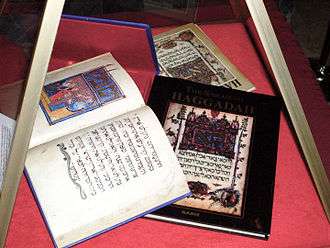History of the Jews in Bosnia and Herzegovina
The history of Jews in Bosnia and Herzegovina spans from the arrival of the first Bosnian Jews as a result of the Spanish Inquisition to the survival of the Bosnian Jews through the Yugoslav Wars and the Holocaust. Judaism and the Jewish community in Bosnia and Herzegovina has one of the oldest and most diverse histories in the former Yugoslav states, and is more than 500 years old, in terms of permanent settlement. Then a self-governing province of the Ottoman Empire, Bosnia was one of the few territories in Europe that welcomed Jews after their expulsion from Spain.

| Total population | |
|---|---|
| 1,000 (estimate) | |
| Languages | |
| Bosnian, Hebrew, Yiddish, Ladino | |
| Religion | |
| Judaism |
Part of a series on the |
|---|
| History of Bosnia and Herzegovina |
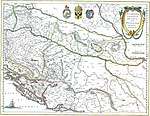 |
|
|
|
Ottoman era
|
|
Habsburgs
|
|
Yugoslavia
|
|
|
At its peak, the Jewish community of Bosnia numbered between 14,000 and 22,000 members in 1941. Of those, 12,000 to 14,000 lived in Sarajevo, comprising 20% of the city's population.[1]
Today, there are an estimated 1,000 Jews living in Bosnia and Herzegovina, recognised as a national minority. They enjoy excellent relations with their non-Jewish neighbors.[2][3]

History

Ottoman rule
The first Jews arrived to Bosnia and Herzegovina in period from 1492 to 1497 from Spain and Portugal.[4] As tens of thousands of Jews fled the Spanish and Portuguese Inquisitions, Sultan Bayezid II of the Ottoman Empire welcomed Jews who were able to reach his territories. Sephardi Jews fleeing Spain and Portugal were welcomed in – and found their way to – Bosnia and Herzegovina, Macedonia, Thrace and other areas of Europe under Ottoman control. Jews from the Ottoman Empire began arriving in numbers in the 16th century, settling mainly in Sarajevo. The first Ashkenazi Jews arrived from Hungary in 1686, when the Ottoman Turks were expelled from Hungary[5][6] Among them was Tzvi Ashkenazi, who remained in Sarajevo for three years as rabbi. The Jewish community prospered in Bosnia, living side by side with their Bosnian Muslim neighbors, as one of the largest European centres for Sephardi Jewry outside of Spain.[2]
Jews in the Ottoman Empire were generally well-treated and were recognized under the law as non-Muslims. Despite some restrictions, the Jewish communities of the Empire prospered. They were granted significant autonomy, with various rights including the right to buy real estate, to build synagogues and to conduct trade throughout the Ottoman Empire.[7] Jews, along with the other non-Muslim subjects of the Empire, were granted full equality under Ottoman law by 1856.
In the late Ottoman time, the Sarajevo-based Sephardi rabbi Judah Alkalai played a prominent role as a precursor of modern Zionism by advocating in favor of the restoration of the Jews to the Land of Israel.
Habsburg rule
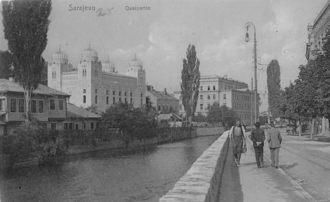
The Austro-Hungarian Empire occupied Bosnia and Herzegovina in 1878, and brought with them an injection of European capital, companies and methods. Many professional, educated Ashkenazi Jews arrived with the Austro-Hungarians. The Sephardi Jews continued to engage in their traditional areas, mainly foreign trade and crafts.[5]
Sephardic Jews have certainly had a stronger role in BiH, given that only in Sarajevo, Banja Luka and Tuzla separate Ashkenazi communities were active, whereas Tuzla was the only city in which the Ashkenazi were numerous (there Hilde Zaloscer was born). In this period Moshe ben Rafael Attias achieved prominence as scholar of the Islamic faith and of medieval Persian literature.
Kingdom of Yugoslavia
World War I saw the collapse of the Austro-Hungarian Empire, and after the war Bosnia and Herzegovina was incorporated into the Kingdom of Yugoslavia. In the census of 1921, Ladino was the mother language of 10,000 out of 70,000 inhabitants of Sarajevo.[8] By 1926, there were 13,000 Jews in Bosnia and Herzegovina.[1]
The Bosnian Jewish community remained prominent after the unification of Yugoslavia. In the 1920s and 1930s Kalmi Baruh was a pioneer of Sephardic studies and Hispanic studies and an eminent leftist intellectual. Daniel Ozmo was active in Belgrade as a progressive painter and printmaker. Isak Samokovlija also started his literary career in the 1930s, which he continued after the war. Laura Papo Bohoreta was an active feminist and writer.
Second world war and the Holocaust in Yugoslavia
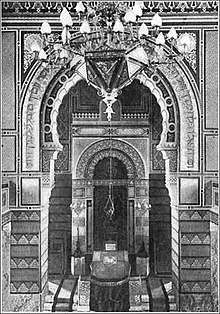
In 1940, there were approximately 14,000 Jews in Bosnia and Herzegovina,[5] with 10,000 in Sarajevo.
With the invasion of Yugoslavia in April 1941 by the Nazis and their Allies, Bosnia and Herzegovina came under the control of the Independent State of Croatia, a Nazi puppet-state. The Independent State of Croatia was headed by the notoriously anti-Semitic Ustaše, and they wasted little time in persecuting non-Croats such as Serbs, Jews and Romani people.
On 22 July 1941, Mile Budak – a senior Minister in the Croatian government and one of the chief ideologists of the Ustaše movement[9] – declared that the goal of the Ustaše was the extermination of "foreign elements" from the Independent State of Croatia. His message was simple: "The basis for the Ustasha movement is religion. For minorities such as Serbs, Jews, and Gypsies, we have three million bullets."[10] In 1941, Ante Pavelić – leader of the Ustaše movement – declared that "the Jews will be liquidated in a very short time".[10]
In September 1941 deportations of Jews began, with most Bosnian Jews being deported to Auschwitz (many first to Kruščica concentration camp) or to concentration camps in Croatia. The Ustaše set up concentration camps at Kerestinac, Jadovna, Metajna and Slana. The most notorious, where cruelty of unimaginable proportions was perpetrated against Jewish and Serbian prisoners were at Pag and Jasenovac. At Jasenovac alone, hundreds of thousands of people were murdered (mostly Serbs), including 20,000 Jews.[11]
By War's end, 10,000 of the pre-War Bosnian Jewish population of 14,000 had been murdered.[1] Most of the 4,000 who had survived did so by fighting with the Yugoslav, Jewish or Soviet Partisans[12] or by escaping to the Italian controlled zone[10] (approximately 1,600 had escaped to the Italian controlled zone on the Dalmatian coast[3] - among them Flory Jagoda, née Kabilio). Jewish members of the Yugoslav Army became German prisoners of war and survived the war. They returned to Sarajevo after the war.[10] Avraham Levi-Lazzaris, who emigrated to Brasil, became explorer of the first mines of diamonds in Rondônia, while Moses Levi-Lazzaris (1944–1990), mechanical engineer, became a Trotskyist militant.
 Višegrad Synagogue (1905-1941)
Višegrad Synagogue (1905-1941) Višegrad Synagogue and train tunnel, 1910
Višegrad Synagogue and train tunnel, 1910 Bijeljina Synagogue (1900-1941)
Bijeljina Synagogue (1900-1941)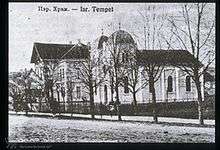 Banja Luka Synagogue (1884-1941)
Banja Luka Synagogue (1884-1941) Site of the proposed Mostar Synagogue
Site of the proposed Mostar Synagogue

Some writers, such as Shaul Shay in his book with suggestive title Islamic Terror and the Balkans, uncritically repeated Serbian apologetic & conspiracy theorist, Carl Savich's outlandish claims put forward on his private website, and Jennie Lebel's contentious book, both referring to accounts alleging that the 13th Waffen Mountain Division of the SS Handschar was responsible for killing more than 90% of Bosnian Jews, rampaging throughout of the war, murdering, raping and even burning entire towns with most populations still trapped in them. However, such unsubstantiated claims are all but discredited.[13][14][15] Handschar units were deployed only after most of the Jews in Croatia and Bosnia had been deported or exterminated by the Ustashe and Nazi regime, or in Serbia by Milan Nedić's collaborationist government. Only one report, which could be plausible, tells the story of an incident in which a Handschar patrol murdered some Jewish civilians, after their real identity was revealed, in or around Zvornik sometimes in April 1944.[16]
Righteous among the Nations from Bosnia and Herzegovina
The people of Sarajevo helped many Jews to abscond and exfiltrate - among many, the story of the Hardaga and Kabilio families[17] as well as of the Sober-Dragoje and Besrević families[18] became particularly notorious after the war. The Righteous among the Nations from Bosnia and Herzegovina are those Bosnians who were honored by the Yad Vashem Memorial as Righteous Among the Nations, i.e. non-Jewish individuals who used their lives to save Jews from murder. Forty-two Bosnians have been awarded the title of Righteous Among the Nations.[19] The spelling of the names follows the list of Yad Vashem, which does not use the diacritics of Serbo-Croatian language:
- Nevenka Baric, 2001
- Zekira Besirevic, 2000
- Marko Bozic, 1989
- Andjelka Brkic, 1996
- Josip Eberhardt & Rozika Eberhardt, 1995
- Hasija & Sulejman Fazlinovic, 1980
- Franjo & Lidija Griner, 1992
- Izet & Bachriya Hardaga, 1984
- Mustafa & Zejneba Hardaga, 1984
- Rezak Hatibovic and his brother Sulejman Hatibovic, 1997
- Semso Kapetanovic and his sisters Esma, Hasna, Vasva and their mother Sultanija, 2001
- Borislav, Borjana, and Ljeposava Komljenovic, 1995
- Dervis & Servet Korkut, 1994
- Andrija Latal, 2006
- Vid and Mato Milosevic, 1997
- Gavro Perkusic, 1999
- Salih Pozder, 1996
- Nurija and Devleta Pozderac, 2012
- Risto Ristic, 1994
- Ahmed Sadik, 1984
- Elza & Ferid Saracevic and their children Sead and Emira, 1994
- Zora Sebek (Krajina), 1995
- Roza Sober-Dragoje, 2000
- Adam Till, 1995
Socialist Yugoslavia
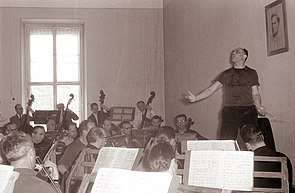
The Jewish Community of Bosnia and Herzegovina was reconstituted after the Holocaust, but most survivors chose to emigrate to Israel.[10] The community came under the auspices of the Federation of Jewish Communities in Yugoslavia, based in the capital, Belgrade.
Jewish personalities remained prominent in Socialist Bosnia and Herzegovina. Cvjetko Rihtman was the first director of the Sarajevo Opera in 1946–1947; his son Ranko will later be part of the Sarajevo rock band Indexi. Oskar Danon also achieved fame as composer and conductor during Yugoslav times. Ernest Grin was one of the leading Yugoslav medical doctors and member of Bosnia and Herzegovina Academy of Sciences and Arts. Emerik Blum, founder of Energoinvest, was Sarajevo's mayor from 1981 to 1983 and member of the Organizational Committee of the 1984 Winter Olympics. Ivan Ceresnjes was active as an architect, supervising the restoration of Jewish buildings and sites, including the Ashkenazi Synagogue, the Kal Nuevo temple and the 16th-century Old Jewish Cemetery, Sarajevo, whose project he was slated to present 24h before the war broke out in March 1992.
In the early 1990s, before the Yugoslav Wars, the Jewish population of Bosnia and Herzegovina was over 2,000,[1] and relations between Jews and their Catholic, Orthodox and Muslim neighbors were very good.
War in Bosnia and Herzegovina
The Jewish community of Bosnia and Herzegovina was headed by Ivan Ceresnjes from 1992 until his emigration to Israel in 1996.[20][21][22][23] His tenure coincided with the Bosnian War of 1992–1995.[21][24] When the besieging Serb army occupied the Jewish cemetery in Sarajevo, Ceresnjes gave permission to the Army of the Republic of Bosnia and Herzegovina to bomb the cemetery.[25]
The Sarajevo Jewish humanitarian society, La Benevolencija, also provided aid to thousands of besieged Sarajevo residents, supplying food, medicine, and postal and radio communications.[26][27] Ceresnjes told a local paper that the nonsectarian relief effort was partly a gesture of gratitude to local Muslims who had hidden Jews during the Nazi occupation of Yugoslavia.[28] After the war started, La Benevolencija assisted the American Jewish Joint Distribution Committee in the evacuation of 2,500 Sarajevo residents, only one-third of whom were Jewish. There were 11 evacuations in all, three by air early on in the war, and eight by bus convoy after the airport had been closed to civilian traffic.[26] While other convoys were stopped, the Ceresnjes convoys all got through, as field staff from the Joint negotiated cease fires to ensure safe transfer.[29]
In 1997, the Jewish population of Bosnia and Herzegovina was 600, about half of whom were living in Sarajevo.[30] Most Jews who had fled Sarajevo and Bosnia chose to remain in Israel after the wars had ended, though some returned[3] and others moved elsewhere, such as Robert Rothbart (born Boris Kajmaković).
Independent Bosnia and Herzegovina
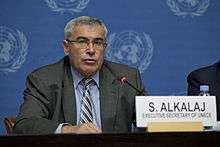
The Jewish Community in Bosnia and Herzegovina has been led by Jakob Finci since 1995. The Constitution of Bosnia and Herzegovina reserves certain top political positions, including the one of President of Bosnia and Herzegovina and of member of the country's upper chamber, to the members of the three constitutive peoples (Bosniaks, Croats and Serbs).[31] In 2009 the European Court of Human Rights established in the Sejdić and Finci v. Bosnia and Herzegovina ruling that the country's Constitution violates the European Convention on Human Rights. An agreement between political parties to amend the Constitution accordingly is still pending, notwithstanding international pressure.[32] This has not prevented Bosnian Jews from achieving prominent positions: among them, Sven Alkalaj was Minister of Foreign Affairs of Bosnia and Herzegovina from 2007 to 2011.
Culture
Sarajevo Haggadah
The Sarajevo Haggadah is a 14th-century illuminated manuscript which has survived many close calls with destruction. Historians believe that it was taken out of Spain by Spanish Jews who were expelled by the Inquisition in 1492. Notes in the margins of the Haggadah indicate that it surfaced in Italy in the 16th century. It was sold to the national museum in Sarajevo in 1894 by a man named Joseph Kohen.
During World War II, the manuscript was hidden from the Nazis by Dr. Jozo Petrovic,[33] the director of the city museum[34] and by Derviš Korkut, the chief librarian, who smuggled the Haggadah out to a Muslim cleric in a mountain village near Treskavica, where it was hidden in the mosque among Korans and other Islamic texts.[35] During the Bosnian War of 1992–1995, when Sarajevo was under constant siege by Bosnian Serb forces, the manuscript survived in an underground bank vault.
Afterwards, the manuscript was restored through a special campaign financed by the United Nations and the Bosnian Jewish community in 2001, and went on permanent display at the museum in December 2002.[2]
Synagogues
.jpg)
The oldest synagogues in Bosnia and Herzegovina were built by the Sephardi community in the XVI century. During the Austro-Hungarian period, the new Ashkenazi community also built their own temples, often adopting the Moorish Revival architectural style, as in the case of Sarajevo's Ashkenazi Synagogue. Most of them were destroyed during World War Two, including Sarajevo's Il Kal Grande.[36] Four synagogues remain in Sarajevo:
- The Old Temple (Stari Hram, also known as Sijavuš-pašina daira or Velika Avlija): A Sephardi synagogue together with a large inn named the Great Courtyard is known to have been built in 1581 with the donation of Turkish Beylerbey Sijamush Pasha to help the poor members of the Jewish community in Sarajevo. It endured two fires in 1697 and 1768. The temple's current looks stems from restoration/renovations in 1821. It now serves as a Jewish museum.
- The New Temple (Novi Hram/Kal Nuevo): Built alongside the Old Temple, today it serves as an art gallery owned by the Jewish community of Sarajevo.
- The Bjelave Synagogue (Kal Di La Bilava): During WW2 the building was confiscated by the Ustaše and was used as a detention facility.
- The Ashkenazi Synagogue: Designed by Karel Pařík and built in 1902 for the growing Ashkenazi community in the Moorish Revival architectural style.
In the rest of the country some synagogue buildings have been preserved and renovated (such as in Doboj) but they do not host services. The Jewish cultural center Arie Livne was opened in Banja Luka in 2015.
 Sarajevo's Old Temple
Sarajevo's Old Temple- Sarajevo's New Temple (Kal Nuevo)
 Sarajevo's Bjelave Synagogue (Kal di la Bilava)
Sarajevo's Bjelave Synagogue (Kal di la Bilava)- Sarajevo's Ashkenazi Synagogue
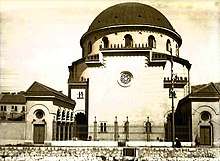 Postcard of Il Kal Grande between 1932-1941
Postcard of Il Kal Grande between 1932-1941
Cemeteries
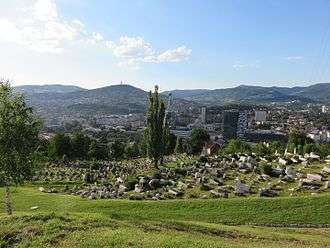
- Old Jewish Cemetery, Sarajevo
- Rogatica Jewish Cemetery: established in 1900, it hosts 16 tombstones plus 10 others probably older, stones sunk in the ground. Tumbs hold inscriptions in Hebrew, Ladino and Serbo-Croatian. There is also a memorial to the victims in the Second World War.[37]
- Burial site of Rabbi Moshe Danon in Stolac (1832, The Sarajevo Megilla), restored by Ivan Ceresnjes in 1990-1991
 Sarajevo's Jewish Cemetery in a 1900 print
Sarajevo's Jewish Cemetery in a 1900 print- The grave of Rabbi Moshe Danon chief Rabbi of Sarajevo (1815-1830), Located in Stolac, Bosnia and Herzegovina
 Jewish cemetery in Rogatica
Jewish cemetery in Rogatica

Prominent Bosnian Jews
- Vanja Albahari, actor
- Judah Alkalai, Rabbi, early member of the Zionist movement
- Sven Alkalaj, Minister of Foreign Affairs of Bosnia and Herzegovina from 2007 to 2011
- Moshe ben Rafael Attias (1845–1916), scholar of Islamic Law and medieval Persian literature
- Kalmi Baruh, writer and philosopher[38]
- Emerik Blum, businessman, founder of Energoinvest, former Mayor of Sarajevo[39]
- Laura Papo Bohoreta, feminist writer (1891–1942)
- Ivan Ceresnjes, architect-researcher, former president of the Jewish community of Bosnia and Herzegovina and vice-chairman of the Yugoslav Federation of Jewish Communities from 1992–1996[40]
- Oskar Danon, composer and conductor[41]
- Rav Moshe Danon, known as the Rabbi of Stolac
- David Elazar, Israeli general and Chief of Staff of Israel Defense Forces[42]
- Jakob Finci, current spiritual leader of the Bosnian Jewish community.
- Ernest Grin (1899–1976), Academician, professor, medical doctor, member of Bosnia and Herzegovina Academy of Sciences and Arts, laureate of AVNOJ award, WHO expert, founder of several medical establishments in the aftermath of WW2
- Flory Jagoda, American guitarist, composer and singer, known for her interpretations of Ladino songs, including her composition for Hanukkah, Ocho Kandelikas.
- Avraham Levi-Lazzaris (1905–2008), businessman, explorer of the first mines of diamonds in Rondônia, Brazil, Holocaust survivor.
- Moses Levi-Lazzaris (1944–1990), mechanical engineer, Trotskyist militant in Brazil, Holocaust survivor.
- Zoran Mandlbaum (1946–2015), Leader of the Jewish Community in Mostar during the War
- Daniel Ozmo (1912–1942), painter and printmaker
- Roza Papo, military physician and general
- Ranko Rihtman, musician, member of the Sarajevo rock band Indexi
- Cvjetko Rihtman, musicologist, folklorist, composer and first director of the Sarajevo Opera in 1946–1947
- Robert Rothbart, basketball player[43]
- Isak Samokovlija, writer[44]
- Sanda Smital, painter
- Marina Toschich, world-renowned musician and master oud player.
- Hilde Zaloscer (1903–1999) World-renowned art historian, Egyptologist and Coptologist.
See also
- Sarajevo Synagogue
- Sarajevo Haggadah
- La Benevolencija
- Jewish cultural center Arie Livne, opened in Banja Luka in 2015.
Further reading
- The Righteous Among the Nations – Bosnian Muslim Rescuers in Sarajevo: Mustafa and Zejneba Hardaga, Izet and Bachrija Hardaga, Ahmed Sadik[17]
- The Righteous Among the Nations – Bosnian Rescuers: Roza Sober-Dragoje and Zekira Besrević[18]
References
- "Bosnia-Herzegovina". Jewish Virtual Library. Retrieved 24 April 2012.
- Makovi, Michael (10 November 2009). "Sarajevo Rose: A Balkan Jewish Notebook". Jewcy. Archived from the original on 9 February 2010. Retrieved 30 May 2015.
- American Jewish Joint Distribution Committee – Bosnia-Herzegovina Archived 2 May 2004 at Archive.today
- "BOSNIA". JewishEncyclopedia.com. Retrieved 24 April 2012.
- Excerpts from Jews in Yugoslavia – Part I Archived 16 July 2006 at the Wayback Machine
- Buda
- "Macedonia and the Jewish people", A. Assa, Skopje, 1992, p.36
- El español en el mundo. Anuario 2004. El español en Bosnia-Herzegovina. Situación de los estudios de español fuera de la Universidad de Sarajevo, Sonia Torres Rubio.
- Mile Budak
- "Jasenovac-Donja Gradina 1941–1945" Archived 13 January 2010 at the Wayback Machine
- Jews of Yugoslavia 1941–1945 Victims of Genocide and Freedom Fighters, Jasa Romano, p7
- "Remembering the Past – Jewish culture battling for survival in Macedonia, Zhidas Daskalovski". Ce-review.org. Retrieved 24 April 2012.
- Hoare, Marko Attila (2014). The Bosnian Muslims in the Second World War: A History. Oxford University Press. pp. 39–54, 103–150, 232, 256. ISBN 9780199327850. Retrieved 15 January 2019.
- Hoare, Marko Attila. Genocide and resistance in Hitler's Bosnia: the Partisans and the Chetniks, 1941-1943. For the British Academy by Oxford University Press 2006. pp. 0–386 (only snippet view). ISBN 9780197263808. Retrieved 15 January 2019.
- Enver Redžić; Robert J. Donia (2005). "Chapter 4: Bosnian Muslim policies p.164". In Robert J. Donia (ed.). Bosnia and Herzegovina in the Second World War. Psychology Press. pp. 164–197. ISBN 978-0-7146-5625-0. Retrieved 15 January 2019.
- Sells 2015, p. 747 n.33
- http://www.yadvashem.org/yv/de/righteous/statistics.asp
- "The Destruction of the Memory of Jewish Presence in Eastern Europe; a Case Study: Former Yugoslavia – Interview with Ivan Ceresnjes". Jerusalem Center for Public Affairs. December 2008. Retrieved 14 May 2011.
- Serageldin, Ismail; Shluger, Ephi; Martin-Brown, Joan (January 2001). Historic Cities and Sacred Sites: Cultural roots for urban futures. World Bank Publications. p. 313. ISBN 0-8213-4904-X.
- Schwartz, Stephen (2005). Sarajevo Rose: A Balkan Jewish notebook. Saqi. p. 70ff. ISBN 0-86356-592-1.
- Davico, Leon (June 1993). "Passover in Sarajevo". UNESCO Courier. Retrieved 14 May 2011.
- Schwartz, Stephen (2 January 2004). "Historic Cemetery in Serbia Desecrated". The Forward. Retrieved 14 May 2011.
- Allen, Beverly (February 1996). Rape Warfare: The hidden genocide in Bosnia-Herzegovina and Croatia. University of Minnesota Press. p. 14. ISBN 978-0-8166-2818-6.
- Shanker, Thom (10 October 1994). "Do Unto Others: In the midst of Bosnia's ethnic bloodbath, innocents find a lifeline in the Jewish community". Chicago Tribune. Retrieved 14 May 2011.
- Polonovski, Max (2002). Le Patrimoine Juif Europeen Actes Du Colloque International Tenu a Paris, Au Musee D'Art Et D'Histoire Du Judaisme, Les 26, 27 Et 28 Janvier 1999: Actes Du Colloque International Tenu a Paris, Au Musee D'Art Et D'Histoire Du Judaisme, Les 26, 27 Et 28 Janvier 1999. Peeters. p. 44. ISBN 90-429-1177-8.
- Gay, Lance (10 April 1993). "Jews Repay Bosnian Muslims". The Vindicator. Archived from the original on 12 August 2011. Retrieved 14 May 2011.
- London, Charles (2009). Far From Zion: In search of a global Jewish community. William Morrow and Company. p. 137. ISBN 0-06-156106-1.
- "The Jewish Community of Sarajevo". The Museum of the Jewish People at Beit Hatfutsot.
- Jew challenges Bosnia presidency ban, Yaniv Salama-Scheer, Jerusalem Post, 18 February 2007.
- Bosnia Jew seeks to reverse ban on running for president, Haaretz, 5 June 2009
- Vlajko Palavestra, PRIČANJA O SUDBINI SARAJEVSKE HAGGADE Archived 7 January 2007 at the Wayback Machine

- Unsung Heroes of the Holocaust at Catholic Online
- Geraldine Brooks, Chronicles, "The Book of Exodus," The New Yorker, 3 December 2007, p. 74
- Heritage & Heritage Sites - Bosnia and Herzegovina
- ROGATIČKI JEVREJI
- http://www.benevolencija.eu.org/index.php?option=com_docman&task=doc_view&gid=70
- "Central and Eastern European Online Library – An Online Library where CEE articles, documents, journals, periodicals, books are available online for download". CEEOL. Retrieved 24 April 2012.
- "The Destruction of the Memory of Jewish Presence in Eastern Europe; a Case Study: Former Yugoslavia – Interview with Ivan Ceresnjes". Jerusalem Center for Public Affairs. December 2008. Retrieved 14 May 2011.
- Voices of Yugoslav Jewry By Paul Benjamin Gordiejew, Pg 62
- "David Elazar – Britannica Online Encyclopedia". Britannica.com. 14 April 1976. Retrieved 24 April 2012.
- "ספסל- הבית של הכדורסל הישראלי – אינפורמציה, סטטיסטיקה וחדשות יומיות על כל השחקנים, הקבוצות והליגות". Safsal.co.il. 24 February 2007. Archived from the original on 6 February 2012. Retrieved 24 April 2012.
- Palavestra, Predrag (2000). Translated by E.D. Goy and Jasna Levinger-Goy. "Jewish Writers in Serbian Literature: Isak Samokovlija" (PDF). Journal of the North American Society for Serbian Studies. Bloomington, IN, USA: Slavica Publishers. 14 (1): 65–68. ISSN 0742-3330. Archived from the original (PDF) on 26 September 2007. Retrieved 30 May 2015.
External links
- Excerpts from Jews in Yugoslavia – Part I
- Jewish Virtual Library – Bosnia-Herzegovina, Stephanie Persin
- American Jewish Joint Distribution Committee – Bosnia-Herzegovina
- Bosnian Jewry: A Small Community Meets a Unique Challenge During the 1990s War – Interview with Ivica Ceresnjes (Interviewed by Manfred Gerstenfeld)
- Interesting Story about Jews living in BiH, from 1930s until Today



